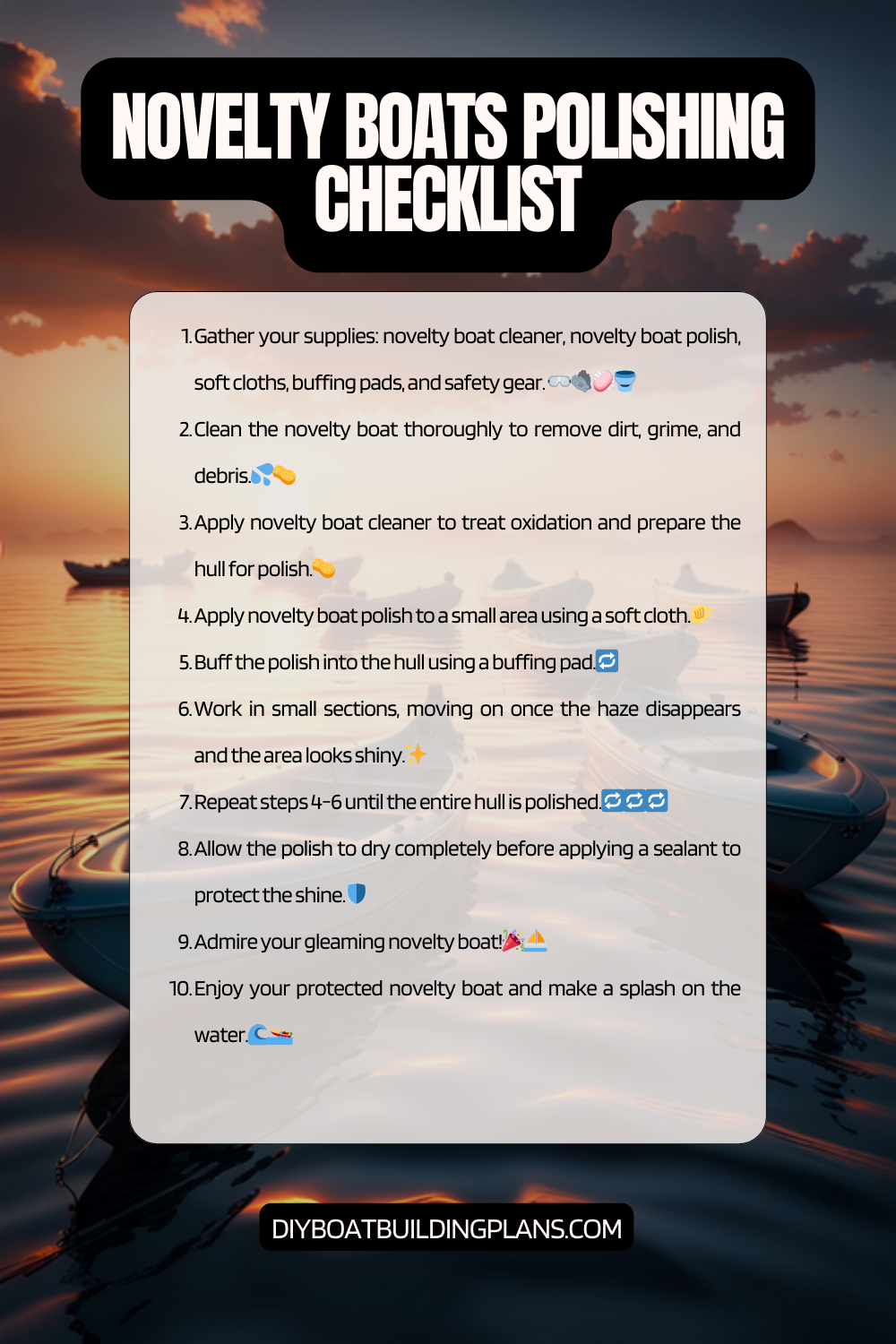Overview of Novelty Boat Polishing Tips
Boat polishing is the process of restoring and enhancing the appearance of a boat’s exterior surfaces. It involves the use of specialized products and techniques to remove imperfections, such as oxidation, scratches, and swirl marks, and to bring back the shine and luster of the boat’s finish. Boat polishing is an essential part of boat maintenance, as it not only improves the aesthetics but also provides protection against environmental factors that can damage the boat’s surfaces.
Key Takeaways
- Boat polishing is important to maintain the appearance and value of your boat.
- There are different types of boat polishing products available, so it’s important to choose the right one for your boat’s material.
- Proper preparation of the boat before polishing is crucial for achieving the best results.
- Polishing techniques vary depending on the material of the boat, and there are tips for polishing hard-to-reach areas.
- To maintain the shine of your boat, it’s important to avoid common mistakes and regularly maintain the polished surface.

Importance of Boat Polishing
One of the primary reasons why boat polishing is important is because it provides protection against environmental factors. Boats are constantly exposed to harsh elements such as UV rays, saltwater, pollutants, and dirt. Over time, these factors can cause damage to the boat’s surfaces, leading to fading, discoloration, and deterioration. By regularly polishing the boat, a protective layer is created that acts as a barrier against these elements, preventing them from causing long-term damage.
In addition to protection, boat polishing also enhances the appearance of the boat. A well-polished boat shines and sparkles in the sunlight, giving it a fresh and attractive look. This is particularly important for boat owners who take pride in their vessels and want them to stand out on the water. A polished boat not only looks great but also gives a positive impression to others, whether it’s fellow boaters or potential buyers if you ever decide to sell your boat.
Furthermore, boat polishing increases the lifespan of the boat. By regularly removing contaminants and imperfections from the surfaces, the integrity of the boat’s finish is preserved. This helps prevent further deterioration and extends the life of the boat. A well-maintained boat not only retains its value but also ensures that you can enjoy many more years of boating without having to worry about costly repairs or replacements.
Types of Boat Polishing
There are three main types of boat polishing products that are commonly used: cutting compound, polishing compound, and finishing compound. Each type serves a specific purpose in the boat polishing process.
Cutting compound is the most aggressive type of polish and is used to remove heavy oxidation, deep scratches, and other severe imperfections. It contains abrasive particles that effectively cut through the damaged layers of the boat’s finish, revealing a fresh surface underneath. Cutting compound should be used with caution, as excessive use or improper technique can result in further damage to the boat’s surfaces.
Polishing compound is a less aggressive polish that is used to refine the surface after using a cutting compound. It helps to remove finer scratches and swirl marks, leaving a smoother and more uniform finish. Polishing compound contains smaller abrasive particles than cutting compound, allowing for a gentler polishing action.
Finishing compound is the least aggressive type of polish and is used to achieve a high-gloss finish. It does not contain abrasive particles and instead relies on chemical agents to enhance the shine of the boat’s surfaces. Finishing compound is typically used as the final step in the boat polishing process to bring out the maximum luster and brilliance.
Choosing the Right Polishing Products
| Polishing Product | Benefits | Drawbacks | Price Range |
| Carnauba Wax | Provides a deep, glossy shine. Protects against UV rays and water damage. | Requires frequent reapplication. Can be difficult to remove if applied improperly. | 10-50 |
| Ceramic Coating | Long-lasting protection against scratches, UV rays, and water damage. Provides a high-gloss finish. | Expensive. Requires professional application. Can be difficult to remove if applied improperly. | 500-1,500 |
| Polishing Compound | Removes scratches and swirl marks. Restores shine to dull or faded paint. | Can be abrasive if used improperly. Requires a lot of elbow grease to apply. | 10-30 |
| All-in-One Polish | Cleans, polishes, and protects in one step. Can be used on multiple surfaces. | May not provide as deep of a shine as other products. May require multiple applications for heavily damaged surfaces. | 20-50 |
When choosing polishing products for your boat, there are several factors to consider. Firstly, you need to determine the type of boat you have and its specific needs. Different types of boats may require different types of polishes, depending on their materials and finishes. For example, fiberglass boats may require a different polish than aluminum boats.
Secondly, consider the condition of your boat’s surfaces. If your boat has severe oxidation or deep scratches, you may need a more aggressive cutting compound to effectively remove these imperfections. On the other hand, if your boat’s surfaces are in relatively good condition and only require minor touch-ups, a milder polishing compound may be sufficient.
Lastly, take into account your own skill level and experience with boat polishing. Some polishes require more expertise and precision to achieve optimal results, while others are more forgiving and easier to work with. If you’re a beginner, it’s recommended to start with less aggressive polishes and gradually work your way up as you gain more confidence and experience.
For fiberglass boats, some recommended polishing products include 3M Marine Restorer and Wax, Meguiar’s Fiberglass Restoration System, and Collinite Fiberglass Boat Wax. For aluminum boats, products like Star brite Aluminum Polish and Flitz Aluminum PreClean are popular choices. Gelcoat surfaces can benefit from products such as 3M Perfect-It Gelcoat Heavy Cutting Compound and Meguiar’s M4916 Marine/RV Heavy Duty Oxidation Remover. Stainless steel surfaces can be polished using products like Flitz Stainless Steel & Chrome Cleaner and Polish or Mothers Mag & Aluminum Polish.
Preparing the Boat for Polishing
Before starting the boat polishing process, it’s important to properly prepare the boat’s surfaces. This involves several steps to ensure that the polish can effectively adhere to the surfaces and achieve optimal results.
The first step is to thoroughly clean the boat. Use a mild detergent or boat soap and a soft brush or sponge to remove any dirt, grime, or salt residue from the surfaces. Pay special attention to hard-to-reach areas, such as crevices and corners, as these areas tend to accumulate more dirt.
Next, remove any old wax or polish that may be present on the boat’s surfaces. This can be done using a wax remover or a specialized stripping agent. Apply the remover according to the manufacturer’s instructions and use a soft cloth or sponge to gently wipe away the old wax or polish.
To protect non-painted areas of the boat from accidental contact with polishing products, it’s recommended to mask them off using painter’s tape or masking film. This will prevent any potential damage or discoloration to these areas during the polishing process.
Polishing Techniques for Different Boat Materials
The techniques used for boat polishing can vary depending on the material of the boat. Here are some specific techniques for different boat materials:
For fiberglass boats, start by applying a cutting compound using a rotary buffer or a dual-action polisher. Work in small sections, applying moderate pressure and moving the buffer in overlapping motions. Once the cutting compound has been applied, switch to a polishing compound and repeat the process to refine the surface. Finally, apply a finishing compound using a soft foam pad to achieve a high-gloss finish.
For aluminum boats, start by cleaning the surfaces with a mild detergent or aluminum cleaner to remove any dirt or oxidation. Next, apply an aluminum polish using a soft cloth or applicator pad. Work in small circular motions, applying moderate pressure. Once the polish has been applied, use a clean cloth to buff away any residue and reveal a shiny finish.
For gelcoat surfaces, start by applying a heavy-duty oxidation remover using a rotary buffer or a dual-action polisher. Work in small sections, applying moderate pressure and moving the buffer in overlapping motions. Once the oxidation remover has been applied, switch to a polishing compound and repeat the process to refine the surface. Finally, apply a high-quality wax or sealant to protect and enhance the shine of the gelcoat.
For stainless steel surfaces, start by cleaning the surfaces with a stainless steel cleaner or vinegar solution to remove any dirt or stains. Next, apply a stainless steel polish using a soft cloth or applicator pad. Work in small circular motions, applying moderate pressure. Once the polish has been applied, use a clean cloth to buff away any residue and reveal a mirror-like finish.
Tips for Polishing Hard-to-Reach Areas
Polishing hard-to-reach areas of your boat can be challenging but not impossible. Here are some tips to help you tackle those tricky spots:
1. Use specialized tools: Invest in specialized polishing tools that are designed to reach tight spaces, such as mini polishers or polishing cones. These tools are smaller and more maneuverable, allowing you to effectively polish areas that are difficult to reach with larger buffers.
2. Be patient and careful: Polishing hard-to-reach areas requires patience and attention to detail. Take your time and work in small sections, ensuring that you cover every inch of the surface. Be careful not to apply too much pressure, as this can result in damage to the surfaces.
3. Use the right technique: Depending on the area you’re working on, you may need to adjust your polishing technique. For example, if you’re polishing a vertical surface, such as a hull side, it’s best to work from top to bottom to prevent any streaking or unevenness.
How to Remove Scratches and Swirl Marks
Scratches and swirl marks can detract from the overall appearance of your boat’s finish. Here’s how you can effectively remove them:
1. Identify scratches and swirl marks: Inspect your boat’s surfaces under proper lighting conditions to identify any scratches or swirl marks. Scratches are typically deeper and more visible, while swirl marks appear as fine circular patterns on the surface.
2. Use the right products and techniques: For shallow scratches and swirl marks, a polishing compound or a light cutting compound can be used. Apply the product using a soft cloth or foam pad and work in small circular motions. Gradually increase the pressure until the imperfections start to fade away. For deeper scratches, a more aggressive cutting compound may be required.
3. Follow up with a polishing compound: Once the scratches and swirl marks have been removed, follow up with a polishing compound to refine the surface and restore the shine. Apply the polishing compound using a soft cloth or foam pad and work in small circular motions. Buff away any residue with a clean cloth to reveal a smooth and glossy finish.
Maintaining the Shine of Your Boat
To maintain the shine of your boat after polishing, regular cleaning and maintenance are essential. Here are some tips to help you keep your boat looking its best:
1. Regularly clean your boat: Wash your boat with a mild detergent or boat soap after each use to remove any dirt, salt residue, or pollutants. Use a soft brush or sponge to gently scrub the surfaces, paying attention to hard-to-reach areas. Rinse thoroughly with fresh water to remove any soap residue.
2. Apply wax and polish as needed: Depending on the condition of your boat’s surfaces, you may need to apply wax or polish periodically to maintain the shine and protection. Follow the manufacturer’s instructions for application and use a soft cloth or applicator pad to evenly distribute the product. Buff away any residue with a clean cloth for a smooth and glossy finish.
3. Protect your boat from the elements: When not in use, cover your boat with a high-quality boat cover or store it in a covered area to protect it from UV rays, rain, and other environmental factors. This will help prevent fading, discoloration, and deterioration of the boat’s surfaces.
Download over 500 Boat Plans. Click on the link below.
-->Click Here<--
Common Mistakes to Avoid When Polishing Your Boat
While boat polishing can be a rewarding process, there are some common mistakes that should be avoided to achieve optimal results:
1. Using the wrong products: Using the wrong polishing products for your specific boat can result in ineffective polishing or even damage to the surfaces. Always choose products that are recommended for your boat’s material and finish.
2. Applying too much pressure: Applying excessive pressure during polishing can cause swirl marks, scratches, or even burn through the gelcoat or paint. Use moderate pressure and let the polishing compound do the work.
3. Not following the correct steps: Skipping or rushing through the necessary steps of boat polishing can lead to subpar results. Take the time to properly clean, prepare, and polish your boat’s surfaces to achieve the best possible outcome.
Novelty Boat Polishing Checklist

Conclusion – Novelty Boat Polishing Tips
In conclusion, boat polishing is a crucial part of boat maintenance that not only enhances the appearance of your boat but also provides protection against environmental factors and increases its lifespan. By choosing the right polishing products, properly preparing the boat’s surfaces, and using the correct techniques, you can achieve a high-gloss finish and keep your boat looking its best.
When it comes to novelty boats, such as wooden boats or classic vessels, there are some additional tips to keep in mind. For wooden boats, it’s important to use specialized wood polishes and sealants that are designed to nourish and protect the wood. Regularly inspect the wood for any signs of rot or damage and address them promptly to prevent further deterioration.
For classic boats with unique finishes or materials, it’s recommended to consult with experts or professionals who have experience working with these types of boats. They can provide valuable advice and guidance on the best products and techniques to use for your specific boat.
In conclusion, taking care of your boat through regular polishing and maintenance is not only a matter of aesthetics but also a way to preserve its value and ensure many years of enjoyable boating experiences. By following the tips and techniques outlined in this article, you can keep your boat looking its best and protect it from the harsh elements of the marine environment.
FAQs – Novelty Boat Polishing Tips
What is boat polishing?
Boat polishing is the process of removing oxidation, stains, and scratches from the surface of a boat to restore its shine and protect it from further damage.
Why is boat polishing important?
Boat polishing is important because it helps to maintain the appearance and value of a boat. It also helps to protect the boat from the damaging effects of the sun, saltwater, and other environmental factors.
What are some tips for polishing a boat?
Some tips for polishing a boat include using the right tools and products, working in small sections, applying even pressure, and using a clean microfiber cloth to buff the surface.
What tools and products are needed for boat polishing?
Tools and products needed for boat polishing include a buffer or polisher, polishing pads, boat polish or compound, and a microfiber cloth.
How often should a boat be polished?
The frequency of boat polishing depends on the condition of the boat and how often it is used. Generally, it is recommended to polish a boat at least once a year, but it may need to be done more frequently if it is exposed to harsh environmental conditions.
Can boat polishing be done by a novice?
Yes, boat polishing can be done by a novice, but it is important to follow the proper techniques and use the right tools and products to avoid damaging the boat’s surface. It may also be helpful to seek advice from a professional or experienced boater.



